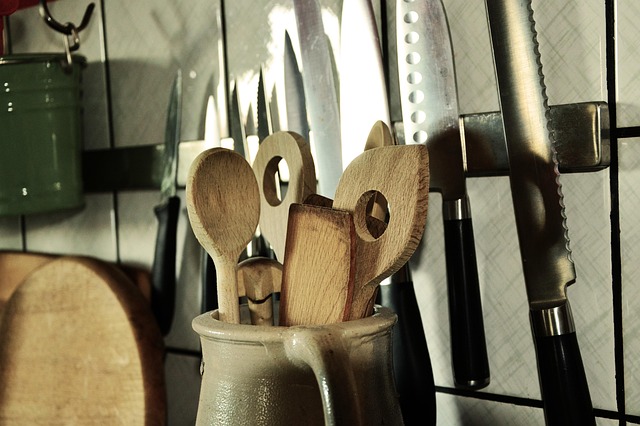Industrial kitchen design prioritizes raw, unfiltered beauty by exposing typically hidden piping and ductwork, creating a striking contrast between modern appliances and metal structures. This trend not only enhances functionality but also serves as a conversation starter, highlighting intricate craftsmanship. Selecting the right materials like steel, brass, or copper alloys is crucial for achieving authenticity. Strategic integration maintains balance, preventing clutter while blending industrial elements with other design choices. Beyond aesthetics, visible piping and ductwork play vital roles in safety and efficiency, aligning with commercial kitchen objectives.
“Unleash the raw, urban charm of industrial kitchens with visible piping and ductwork. This trend transcends mere aesthetics, infusing spaces with an authentic, gritty character. Our guide explores how these structural elements become focal points in modern kitchen design.
From understanding the foundational industrial aesthetic to selecting the right materials and strategic layout planning, we’ll navigate the process. Discover tips for enhancing functionality and safety while embracing this unique design choice, transforming your kitchen into a striking industrial masterpiece.”
Understanding the Industrial Aesthetic: Unveiling the Essence
The industrial aesthetic, a popular trend in interior design, evokes a sense of raw, unfiltered beauty and functionality. In an industrial kitchen design, this translates into exposing elements that are typically hidden behind walls—a key aspect is showcasing visible piping or ductwork. This strategic design choice adds depth and character to the space, bringing a unique, rustic charm that resonates with many.
By incorporating exposed piping, designers can create a striking visual contrast between sleek appliances and rough, metal structures. The result is an authentic, industrial-meets-modern aesthetic that captures the essence of workshopped spaces. This approach not only enhances the overall design but also serves as a conversation starter, drawing attention to the intricate details often overlooked in traditional kitchen layouts.
The Role of Visible Piping and Ductwork in Kitchen Design
In the realm of industrial kitchen design, visible piping and ductwork serve as both functional elements and design statements. These components, typically made from metal or exposed concrete, add a raw, edgy appeal that defines the aesthetic. Unlike traditional sleek and minimalist kitchens, an industrial kitchen embraces its structural elements, integrating them seamlessly into the overall layout.
By leaving piping and ductwork exposed, designers create a sense of transparency, highlighting the intricate details and craftsmanship often hidden behind walls. This approach not only enhances the functional aspects by ensuring easy accessibility for maintenance but also contributes to the overall aesthetic appeal. In industrial kitchen design, these visible elements become the focal points, fostering an atmosphere that is both dynamic and inviting—a far cry from the sterile, enclosed spaces of conventional kitchens.
Choosing Materials: Metal Alloys for an Authentic Look
When aiming for an authentic industrial kitchen design, selecting the right materials is paramount. Metal alloys, in particular, offer a tangible connection to the raw, unpolished look often associated with industrial aesthetics. For visible piping and ductwork, consider alloys like steel, brass, or copper. These metals not only provide a visually striking contrast against sleek finishes but also stand the test of time, reflecting the durable nature of industrial spaces.
Each alloy brings its unique character to the table; steel exudes strength and modernity, brass adds a warm, golden glow that can enhance lighting, while copper offers a rustic, aged appeal. Choosing the right metal for your piping and ductwork can significantly contribute to the overall industrial kitchen design, creating an environment that feels both functional and aesthetically pleasing.
Integrating Visible Elements: Strategies and Layout Considerations
In an industrial kitchen design, integrating visible piping or ductwork can significantly enhance the aesthetic appeal, adding a raw and authentic edge to the space. When incorporating these elements, strategic planning is key. Start by identifying areas where piping and ductwork can be exposed, such as along walls or in open-concept layouts. Consider their placement in relation to appliances and work stations to ensure functionality isn’t compromised while maintaining visual impact.
Layout considerations should also account for the overall flow of the kitchen. Visible piping can serve as a focal point, breaking up large spaces and adding depth. However, balance is crucial; too much exposure might create visual clutter, overwhelming the design. Careful planning allows for a harmonious blend of industrial elements with other design choices, resulting in a cohesive industrial kitchen that’s both functional and striking.
Enhancing Functionality and Safety: Tips for Installation
In an industrial kitchen design, incorporating visible piping or ductwork isn’t just about aesthetics; it significantly enhances functionality and safety. When installed correctly, these elements serve as a critical part of the ventilation system, effectively managing heat and steam to prevent accidents and ensure a comfortable working environment.
During installation, it’s crucial to adhere to local building codes and consult with professionals to guarantee proper air flow and exhaust. Strategically placing ductwork can also help improve the overall layout, allowing for efficient movement of personnel and equipment while maintaining a distinct industrial charm that complements the design goals of any commercial kitchen.
Incorporating visible piping and ductwork into your industrial kitchen design not only enhances aesthetics but also offers a practical approach. By embracing this unique feature, you create an authentic, robust atmosphere that reflects the essence of industrial spaces. With careful material selection, strategic layout planning, and safety considerations, these elements can become a central design point, setting your kitchen apart while ensuring functionality and durability.
